Chapter: Computer Architecture : Memory and I/O Systems
Measuring and Improving Cache Performance
MEASURING AND IMPROVING
CACHE PERFORMANCE
As a working example,
suppose the cache has 27 = 128 lines, each with 24 = 16
words. Suppose the memory has a 16-bit address, so that 216 = 64K
words are in the memory's address space.

Direct Mapping
Under this mapping
scheme, each memory line j maps to cache line j mod 128 so the memory address
looks like this:

Here, the
"Word" field selects one from among the 16 addressable words in a
line. The "Line" field defines the cache line where this memory line
should reside. The "Tag" field of the address is is then compared
with that cache line's 5-bit tag to determine whether there is a hit or a miss.
If there's a miss, we need to swap out the memory line that occupies that
position in the cache and replace it with the desired memory line.
E.g., Suppose we want
to read or write a word at the address 357A, whose 16 bits are
0011010101111010. This translates to Tag = 6, line = 87, and Word = 10 (all in
decimal). If line 87 in the cache has the same tag (6), then memory address
357A is in the cache. Otherwise, a miss has occurred and the contents of cache
line 87 must be replaced by the memory line 001101010111 = 855 before the read
or write is executed.
Direct mapping is the
most efficient cache mapping scheme, but it is also the least effective in its
utilization of the cache - that is, it may leave some cache lines unused.
Associative Mapping
This mapping scheme
attempts to improve cache utilization, but at the expense of speed. Here, the
cache line tags are 12 bits, rather than 5, and any memory line can be stored
in any cache line. The memory address looks like this:

Here, the
"Tag" field identifies one of the 2 12 = 4096 memory
lines; all the cache tags are searched to find out whether or not the Tag field
matches one of the cache tags. If so, we have a hit, and if not there's a miss
and we need to replace one of the cache lines by this line before reading or
writing into the cache. (The "Word" field again selects one from
among 16 addressable words (bytes) within the line.)
For example, suppose
again that we want to read or write a word at the address 357A, whose 16 bits
are 0011010101111010. Under associative mapping, this translates to Tag = 855
and Word = 10 (in decimal). So we search all of the 128 cache tags to see if
any one of them will match with 855. If not, there's a miss and we need to
replace one of the cache lines with line 855 from memory before completing the
read or write.
The search of all 128
tags in the cache is time-consuming. However, the cache is fully utilized since
none of its lines will be unused prior to a miss (recall that direct mapping
may detect a miss even though the cache is not completely full of active
lines).
Set-associative Mapping
This scheme is a
compromise between the direct and associative schemes described above. Here,
the cache is divided into sets of tags, and the set number is directly mapped
from the memory address (e.g., memory line j is mapped to cache set j mod 64),
as suggested by the diagram below:

The memory address is now
partitioned to like this:

Here, the
"Tag" field identifies one of the 26 = 64 different memory
lines in each of the 26 = 64 different "Set" values. Since
each cache set has room for only two lines at a time, the search for a match is
limited to those two lines (rather than the entire cache). If there's a match,
we have a hit and the read or write can proceed immediately.
Otherwise, there's a
miss and we need to replace one of the two cache lines by this line before
reading or writing into the cache. (The "Word" field again select one
from among 16 addressable words inside the line.) In set-associative mapping,
when the number of lines per set is n, the mapping is called n-way associative.
For instance, the above example is 2-way associative.
E.g., Again suppose we
want to read or write a word at the memory address 357A, whose 16 bits are
0011010101111010. Under set-associative mapping, this translates to Tag = 13,
Set = 23, and Word = 10 (all in decimal). So we search only the two tags in
cache set 23 to see if either one matches tag 13. If so, we have a hit.
Otherwise, one of these two must be replaced by the memory line being addressed
(good old line 855) before the read or write can be executed.
A Detailed Example
Suppose we have an
8-word cache and a 16-bit memory address space, where each memory
"line" is a single word (so the memory address need not have a
"Word" field to distinguish individual words within a line). Suppose
we also have a 4x10 array a of numbers (one number per addressible memory word)
allocated in memory column-by-column, beginning at address 7A00. That is, we
have the following declaration and memory allocation picture for
The array a:
float [a = new float [4][10];
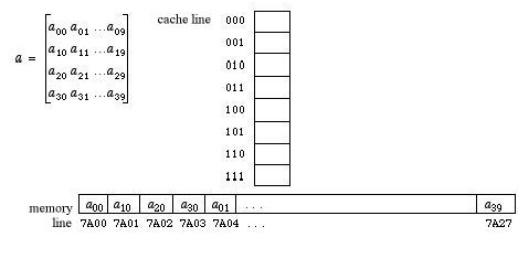
Here is
a simple equation
that recalculates the
elements of the
first row of a:

This
calculation could have been
implemented directly in C/C++/Java
as follows:
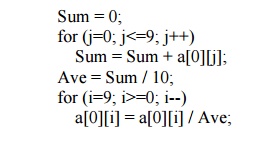
The emphasis here is on
the underlined parts of this program which represent memory read and write
operations in the array a. Note that the 3rd and 6th lines involve a memory
read of a[0][j] and a[0][i], and the 6th line involves a memory write of
a[0][i]. So altogether, there are 20 memory reads and 10 memory writes during
the execution of this program. The following discussion focusses on those
particular parts of this program and their impact on the cache.
Direct Mapping
Direct mapping of the
cache for this model can be accomplished by using the rightmost 3 bits of the
memory address. For instance, the memory address 7A00 = 0111101000000 000,
which maps to cache address 000. Thus, the cache address of any value in the
array a is just its memory address modulo 8.
Using this scheme, we
see that the above calculation uses only cache words 000 and 100, since each
entry in the first row of a has a memory address with either 000 or 100 as its
rightmost 3 bits. The hit rate of a program is the number of cache hits among
its reads and writes divided by the total number of memory reads and writes.
There are 30 memory reads and writes for this program, and the following
diagram illustrates cache utilization for direct mapping throughout the life of
these two loops:
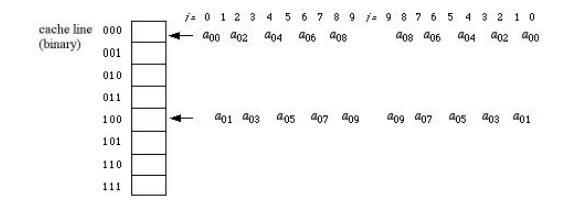
Reading the sequence of
events from left to right over the ranges of the indexes i and j, it is easy to
pick out the hits and misses. In fact, the first loop has a series of 10 misses
(no hits). The second loop contains a read and a write of the same memory
location on each repetition (i.e., a[0][i] = a[0][i]/Ave; ), so that the 10 writes
are guaranteed to be hits. Moreover, the first two repetitions of the second
loop have hits in their read operations, since a09 and a08
are still in the cache at the end of the first loop. Thus, the hit rate for
direct mapping in this algorithm is 12/30 = 40%
Associative Mapping
Associative mapping for
this problem simply uses the entire address as the cache tag. If we use the
least recently used cache replacement strategy, the sequence of events in the
cache after the first loop completes is shown in the left-half of the following
diagram. The second loop happily finds all of a 09 - a02
already in the cache, so it will experience a series of 16 hits (2 for each
repetition) before missing on a 01 when i=1. The last two steps of
the second loop therefore have 2 hits and 2 misses.
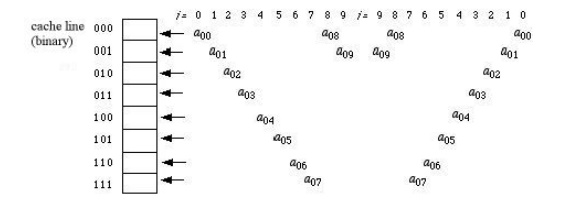
Set-Associative Mapping
Set associative mapping
tries to compromise these two. Suppose we divide the cache into two sets,
distinguished from each other by the rightmost bit of the memory address, and
assume the least recently used strategy for cache line replacement. Cache
utilization for our program can now be pictured as follows:
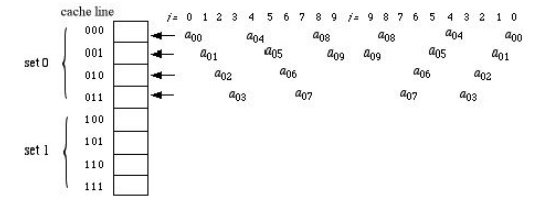
Here all the entries in
a that are referenced in this algorithm have even-numbered addresses (their
rightmost bit = 0), so only the top half of the cache is utilized. The hit rate
is therefore slightly worse than associative mapping and slightly better than
direct. That is, set-associative cache mapping for this program yields 14 hits
out of 30 read/writes for a hit rate of 46%.
Related Topics